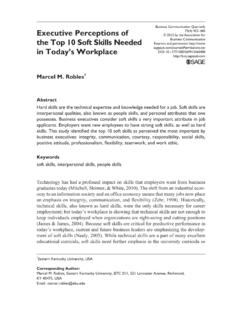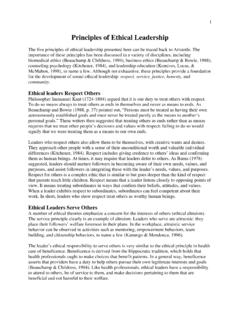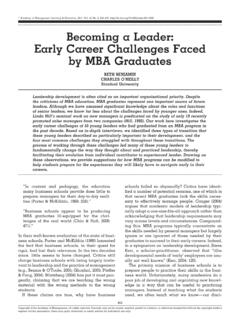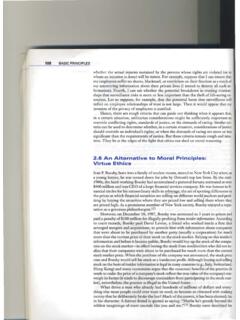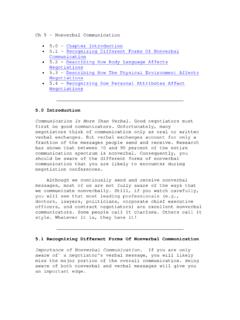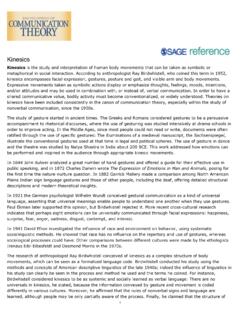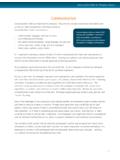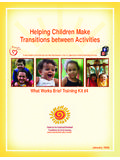Transcription of Nonverbal Behavior and Communication in the Workplace
1 621146. research-article2015. of ManagementBonaccio et al. / Workplace Nonverbal Behavior and Communication Journal of Management Vol. XX No. X, Month XXXX 1 31. DOI: The Author(s) 2016. Reprints and permissions: Nonverbal Behavior and Communication in the Workplace : A Review and an Agenda for Research Silvia Bonaccio Jane O'Reilly Sharon L. O'Sullivan Fran ois Chiocchio University of Ottawa Nonverbal Behavior is a hot topic in the popular management press. However, management scholars have lagged behind in understanding this important form of Communication . Although some theories discuss limited aspects of Nonverbal Behavior , there has yet to be a comprehensive review of Nonverbal Behavior geared toward organizational scholars.
2 Furthermore, the extant literature is scattered across several areas of inquiry, making the field appear disjointed and challenging to access. The purpose of this paper is to review the literature on Nonverbal behav- ior with an eye towards applying it to organizational phenomena. We begin by defining nonver- bal Behavior and its components. We review and discuss several areas in the organizational sciences that are ripe for further explorations of Nonverbal Behavior . Throughout the paper, we offer ideas for future research as well as information on methods to study Nonverbal Behavior in lab and field contexts. We hope our review will encourage organizational scholars to develop a deeper understanding of how Nonverbal Behavior influences the social world of organizations.
3 Keywords: Nonverbal Behavior ; Communication ; social interactions Acknowledgments: We wish to thank Xiaoxi Chang and YanHong Li for their help on the literature review and to acknowledge funding from the Telfer School of Management Cluster Program, administered by the Telfer School of Management at the University of Ottawa. The Telfer School of Management does not have any control over the content of the research conducted or published with the support of these funds. The first and second authors con- tributed in equal parts to this paper; authorship is alphabetical. Corresponding author: Silvia Bonaccio, Telfer School of Management, University of Ottawa, 55 Laurier Ave. East, Ottawa, ON K1N 6N5, Canada.
4 E-mail: 1. Downloaded from at SOUTHEASTERN OKLA STATE UNIV on March 22, 2016. 2 Journal of Management / Month XXXX. Nonverbal Behavior is a popular management press hot topic. In a Forbes blog post, for example, employees are encouraged to display 10 cues to show greater confidence (Smith, 2013). Job seekers are told that interviewers form an opinion of them within 7 s of meeting (Pitts, 2013). Leaders have a silent language, and body language can win negotiations and build trust (Goman, 2011). Women are told to display specific power poses if they want to succeed (Cuddy, 2013). Finally, Sheryl Sandberg, Facebook executive and author of Lean In, is not immune to body language criticism.
5 Her 2013 Time magazine cover was condemned for making her look like a little girl (Wall Street Journal, 2013). Given the clear interest in the popular press for body language and Nonverbal Behavior in general, it is surprising to notice that management scholars have lagged behind in understand- ing this seemingly important form of Communication . Although some theories discuss limited aspects of Nonverbal Behavior , there has yet to be a comprehensive review of Nonverbal behav- ior geared toward organizational scholars. Furthermore, the extant literature is scattered across several fields, most notably Communication , gender studies, cross-cultural studies, social psy- chology, anthropology, and criminology.
6 Even some of the key researchers of Nonverbal behav- ior have characterized aspects within the field as disjointed in several respects (Harrigan, Rosenthal, & Scherer, 2005: 137). As a result, it can be a challenge for organizational scientists interested in studying Nonverbal Behavior to access a concise treatment of this topic. The purpose of this article is to review the literature on Nonverbal Behavior with an eye towards applying it to organizational phenomena. We begin by defining Nonverbal Behavior and its components. We then review several areas in the organizational sciences that are ripe for further explorations into Nonverbal Behavior . We organize our review around several Nonverbal Behavior functions that have implications for organizational life.
7 We also discuss methodological considerations when relevant. By doing so, our review offers a helpful guide for organizational scholars wishing to navigate the vast literature on Nonverbal Behavior . To guide the reader and provide additional ideas and directions, we provide an overview of the five areas of inquiry relevant to management research, as well as pose some research ques- tions for future inquiry, in Table 1. We hope our review will encourage organizational schol- ars to develop a deeper understanding of how Nonverbal Behavior influences the social world of organizations an important endeavor, given that it is estimated that 65% to 93% of all human interaction is fueled by Nonverbal cues (Birdwhistell, 1970).
8 Defining Nonverbal Behavior and Communication Early definitions of Nonverbal Communication highlighted that it does not rely on words or language (see Knapp, 2011, for a historical overview). However, this definition draws a superfi- cial distinction between verbal and Nonverbal Communication . Indeed, Nonverbal communica- tion differs from verbal Communication in that it is Communication that is not linguistic (Burgoon, Guerrero, & Manusov, 2011), which is why American Sign Language, for instance, is consid- ered verbal Communication . Adding a layer of complexity, both verbal and Nonverbal communi- cation possess vocal characteristics, with verbal vocalic referring to the content of the message and Nonverbal vocalic to how the message is conveyed ( , voice tone, accent, pitch; Hargie, 2011).
9 Thus, Nonverbal Communication is understood as the sending and receiving of thoughts and feelings via Nonverbal Behavior (Ambady & Weisbuch, 2010: 465). Any Nonverbal Behavior has the potential to communicate meaning (Burgoon et al., 2011). We emphasize the term potential because while Nonverbal Behavior represents objective Downloaded from at SOUTHEASTERN OKLA STATE UNIV on March 22, 2016. Table 1. A Functional Approach to the Role of Nonverbal Behaviors in Organizations Select Relevant Topics in Function Organizational Research Sample Organizational Research Questions and Problems Display Recruitment, selection, and assessment Which NVB cues are most relevant to assessment/selection decisions, and how do they Personal Performance appraisal influence assessors?
10 Attributes Detection of dishonesty How might context moderate the influence of NVBs on assessment/selection decisions? Displays of integrity How might assessors best be trained to discern deception versus integrity? Exercise Social Power and dominance How might NVB displays of dominance influence negotiations or conflict Control and Abusive supervision management? Establish Harassment/bullying How might hostile NVB codes differ depending on relationship ( , supervisor- Hierarchy Discrimination subordinate vs. coworker)? Negotiation How might sensitivity training help in detecting, documenting, and minimizing hostile Socialization NVBs in the Workplace ? Organizational culture To what extent do hostile NVBs affect organizational climate?
